Recent Storm Damage Posts
Spring Storms and Weather Events in the United States | SERVPRO® of Rutherford County
3/25/2022 (Permalink)
 Extreme temperature changes can lead to severe weather. SERVPRO of Rutherford County is a click away if you experience any damage.
Extreme temperature changes can lead to severe weather. SERVPRO of Rutherford County is a click away if you experience any damage.
Because the United States is one of the world's most significant countries, it has a vast and varied terrain. As a consequence, seasonal weather in the United States isn't uniform—different portions of the country face varying types of weather conditions, which leads to different levels of weather concerns for various locations.
Let's take a look at the weather patterns that can form as spring approaches and warm and cold air masses collide across the country—and what we may learn from them in Tennessee.
From December through April, the Pacific Northwest is prone to heavy rain, which might cause flooding and water damage. Snow will continue to build at higher elevations as the season progresses, bringing difficulties of its own owing to melting and runoff.
The Upper Midwest and Northeast have the longest winter season, with temperatures remaining below freezing for the majority of it. People can anticipate ice storms, blizzards, and even significant snowfall until late spring or early summer in Maine to Minnesota.
Extreme heat waves, on the other hand, will be a major problem in the Southwest and southern West Coast. The possibility of tsunamis produced by tectonic activity in the South Pacific region, including Hawaii, will be high on watch.
From Iowa to Texas, the center of the country will need to be on guard for windstorms, derechos and the prospect of wildfires, which might swiftly spread due to strong winds and arid conditions. Tornado Alley is especially vulnerable to tornadoes, with a large part of this region being known as such.
Finally, throughout the Southeast, we can anticipate a wide range weather events, ranging from thunderstorms and tornadoes in low-lying regions to early-season hurricanes along the shoreline later in the spring. Late-season snow has hit numerous locations in Middle Tennessee.
Extreme weather can happen in any part of the United States. While it varies from state to state, being aware and prepared for severe weather is never a bad idea.
Help is only a phone call or an email away if extreme weather causes you property damage from water, fire, or other forces. For local, rapid, professional restoration, contact SERVPRO of Rutherford County. We are always Here to Help.
6 Severe Storm Safety Tips
2/4/2022 (Permalink)
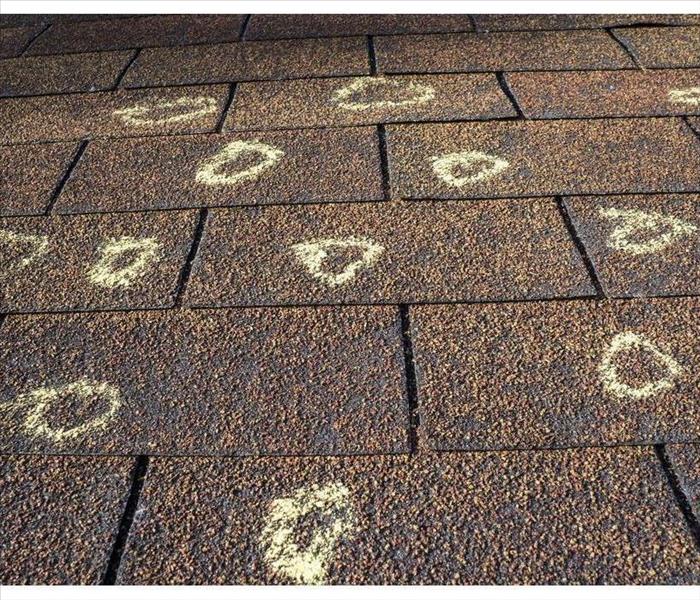 Hail and strong winds can cause damage that may lead to destructive leaks in your roof.
Hail and strong winds can cause damage that may lead to destructive leaks in your roof.
Storm Safety Tips
Depending on the season and your location, your business may be vulnerable to damage from a variety of weather phenomenon, such as an intense rain storm, tornado or hurricane. When a significant weather event occurs, following several key safety guidelines can help you protect your building and safeguard the wellbeing of your staff.
1. Keep Trees Trimmed
Tree branches can become dangerous objects during strong winds. To minimize the risks of broken windows and roof damage, you should keep trees adjacent to your property neatly trimmed and routinely remove dead branches.
2. Stay Away From Windows and Skylights
Flying debris can easily shatter windows and skylights. As a precaution, everyone should move away from these structures during a severe storm with high winds or hail.
3. Elevate Essential Equipment
A significant rain storm can increase the risk of flooding. If floodwaters enter your building, essential equipment, including components of your HVAC system, may be vulnerable to water damage. To alleviate this concern, you should elevate important devices off the floor.
4. Move to an Internal Room
In the event of a tornado, seeking adequate shelter is essential. Your staff should promptly move to the basement or a windowless, interior room on the lowest level of the building.
5. Avoid Using Electronic Equipment
Because cords conduct electricity, using electronic equipment during a thunderstorm can be dangerous. Staff should shutdown computers and avoid using phones until the storm has passed. As an added precaution, you should utilize surge protectors to safeguard vital equipment from potential damage.
6. Inspect Your Roof
Hail and strong winds can wreak havoc on your building’s roof and cause damage that may lead to destructive leaks and potential mold contamination. For this reason, it’s a good idea to inspect your roof after any storm and promptly commence any necessary repairs.
A severe rain storm can produce damaging high winds and cause extensive flooding. Taking proactive measures can help every business in Lascassas, TN, avert serious injuries and minimize the risk of significant destruction.
What You Need To Know About Residential Flood Cleanup
1/12/2022 (Permalink)
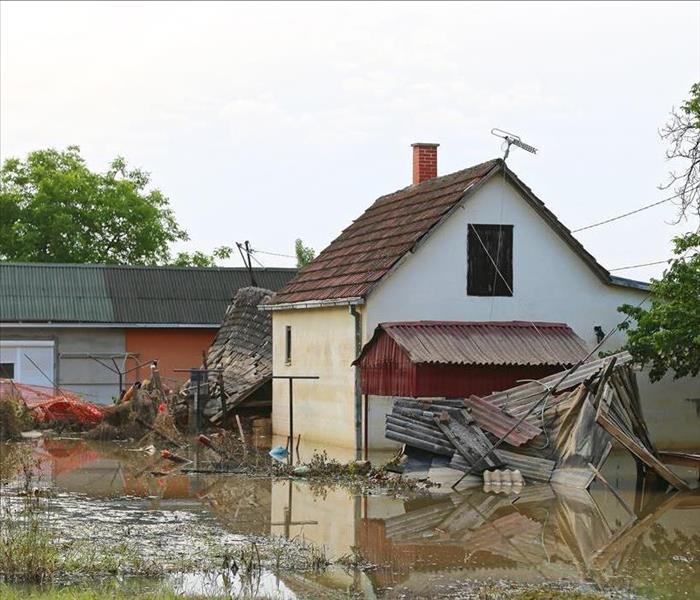 Flood damage in Eagleville, TN
Flood damage in Eagleville, TN
Residential Flood Cleanup
Few things are more tragic than having a home sustain damage during intense storms. After all, not only does your home represent your most significant financial investment, but it also is full of memories, personal keepsakes and valuables. You may not realize, however, that not all flooding is the same. Depending on the type of water damage you have, you must take different steps to restore your Eagleville, TN, home.
Broken Pipes Usually Cause Category One Damage
Unless you are away from your home when a pipe bursts, you are apt to notice this flood damage quickly. While the effects of destroyed plumbing systems can be bad, they are often not as severe as storm-related problems. This type of issue typically includes damage to the following:
- Drywall
- Carpeting
- Furniture
- Personal belongings
Restoration experts usually consider this sort of flooding to be low-level. Cleanup after these floods is often quicker and less invasive than for storm-caused damage.
Storms Often Cause Category Three Damage
When a hurricane, major thunderstorm or other severe weather rolls into town, your home may sustain considerable damage. Experts often assign this damage a category three rating. At this level, water often infiltrates parts of your home that you may not think about. Flood water may affect your basement, crawl space, carpeting, foundation and walls.
Restoration Experts Restore Value, Comfort and Appearance
While high waters can be unbelievably destructive, you may not have to completely abandon your home. On the contrary, restoration specialists usually have the knowledge and equipment necessary to return your home to its pre-flood condition. This first step to regaining your house’s value, comfort and appearance is to schedule an assessment from an emergency restoration service. Note, though, that timing is important. Waiting to start repairs can cause damage to worsen.
While flooding can be heartbreaking, you don’t have to walk away from your treasured home. By understanding the difference between pipe breaks and severe weather, you can best address the situation.
3 Leadership Tips for Inclement Weather
11/10/2021 (Permalink)
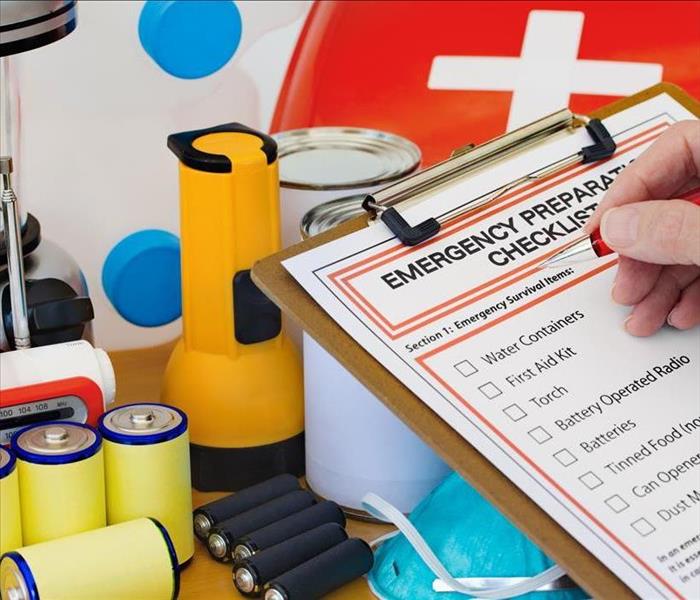 Have emergency supplies at the office.
Have emergency supplies at the office.
3 Leadership Tips for Inclement Weather
When a snow storm hits Murfreesboro, TN, your business is likely to be affected. Worsening road conditions can cause traffic delays or even accidents. As the leader of the company, there are a few things you can do to ensure that your employees and your building stay as safe as possible.
1. Be Informed
You should always keep track of weather forecasts, particularly during storm season. You cannot plan for something you don't know is coming. Having a general idea of when to expect harsh conditions to arise can help you prepare. You can download a weather app on your phone so that this information is always at your fingertips.
2. Be Prepared
Have emergency supplies at the office just in case the snow storm arrives while people are still at work. Flashlights and extra batteries can be useful if the power goes out. Have a backup generator to tide you over until emergency crews can restore power to your building, and have the generator tested regularly so that you know it works. It's also a good idea to stockpile non-perishable food and water just in case people get stranded in the building.
3. Be Flexible
Have an alternative business plan ready for days when it's too treacherous outside to drive to work. If your employees are fortunate enough to make it home before the worst of the storm arrives, let them stay there and telecommute until dangerous conditions subside. Just because there are no people in the building, though, that doesn't mean you need to turn off the heat. Keeping the heater on low throughout the building can help you avoid having to hire remediation specialists to clean up after a pipe burst when the plumbing freezes. This protection is well worth the extra utility costs.
A snow storm doesn't have to disrupt your business too much. Plan ahead and have flexible, alternative ways to keep employees both safe and productive.
Flooded Basement: What's the Cause?
9/19/2021 (Permalink)
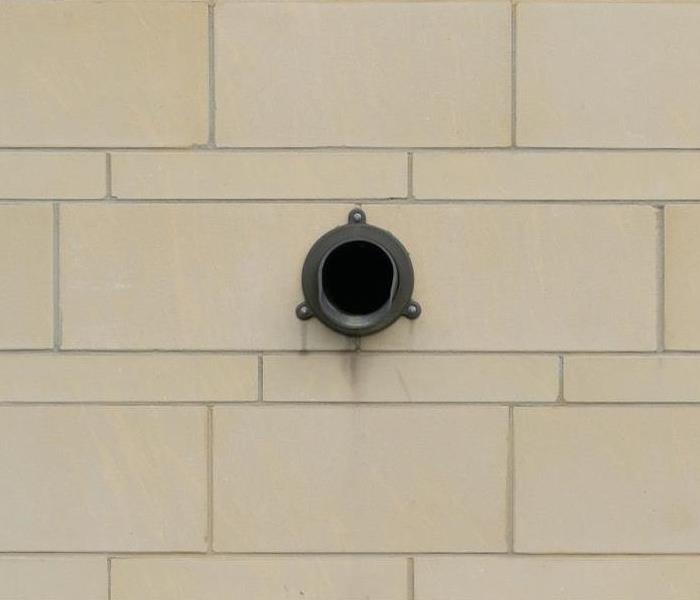 If you're dealing with a flooded basement, the best thing you can do is contact a flood restoration expert for cleanup assistance.
If you're dealing with a flooded basement, the best thing you can do is contact a flood restoration expert for cleanup assistance.
A flooded basement can cause a lot of stress and headache for the average homeowner, as most people store sentimental items, excess furniture, and stockpiled goods in this out-of-the-way area of the home. In addition to causing damage to stored items, unexpected water can destroy the walls, carpet, rugs, and other permanent fixtures.
Common Causes of Sewage Backup
Whether you're experiencing this problem for the first time or have dealt with a flood in the basement before, it's important to determine the cause to ensure that it doesn't happen again. Ask any Milton, TN, floor restoration expert, and he or she will tell you you’re your flooded basement likely occurred because of one of four reasons:
• Water from your home's surface somehow seeped through your foundation.
• Groundwater from outside saturated the soil to the point where it was forced to enter your home via hydrostatic pressure.
• Stormwater built up in the city's sewer system and backed up into your home.
• Your home's sewage line, the city's sewage line or both were clogged and the pressure caused a backup in your home.
Pinpointing the cause of the backup is key to finding a solution and implementing measures to prevent future sewage backups. A skilled plumber can help you determine why your system is backing up and what needs to be done to correct the issue.
Easy Fixes to a Sewage Backup
Not all plumbing issues require an expensive solution. If you're lucky, the fix will be something as simple and affordable as one of the following four solutions:
• Extend your downspouts farther away from your home.
• Redo the pavement around your home so that it slopes away from the foundation.
• Seal the pavement that buts up to your home to prevent water from leaking in through the cracks.
• Re-grade your landscaping so that water flows away from your home.
• Keep lawn irrigation away from your home.
If you're dealing with a flooded basement, the best thing you can do is contact a flood restoration expert for cleanup assistance. Afterward, schedule an appointment with a plumber to determine the root of the issue and fix it for good.
Five Things To Know To Be Prepared for a Flood
8/8/2021 (Permalink)
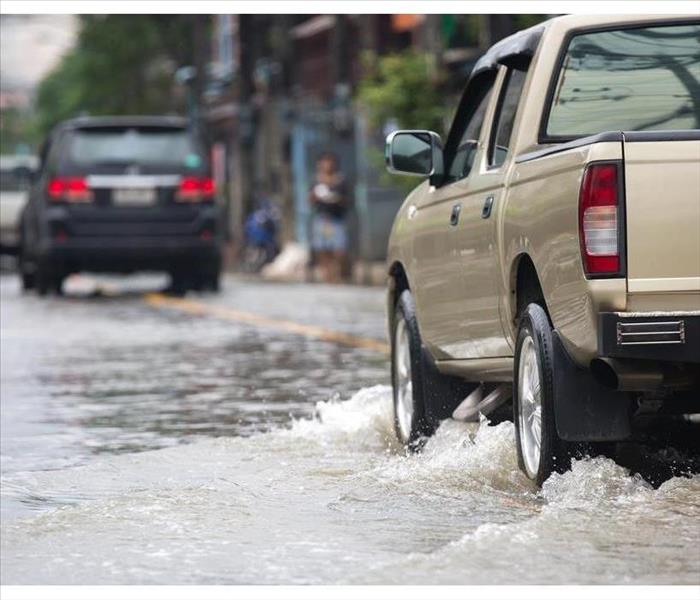 Never drive through flood waters.
Never drive through flood waters.
Five Things You Should Know to Prepare for a Flood
Are you prepared for a flood in Walterhill, TN? This preparation advice may not include conventional flood safety tips, but one of the biggest dangers in any emergency can be panic. With a few simple safety tips, you can mitigate that risk.
1. Know Your Home
Be sure you know what parts of your home may be vulnerable to flooding, such as a basement, and what you can do to mitigate the risk. Keep valuables on higher levels if possible, or make sure you have a place to move them when a storm is approaching.
2. Know the Risk
Is a flood likely in Walterhill, TN? Do some research to understand the likelihood of a flood in your area and what type of flooding to expect. Different types of floods may carry different risks for your home and family.
3. Know Where To Go
Check with your town or surrounding communities to find out where storm shelters are usually set up. Once you know the locations of the shelters, practice safe evacuation routes so you know how to get there. One of the most important flood safety tips is knowing how to travel during a flood, including never walking or driving through flood waters and avoiding bridges over swollen waterways.
4. Know What To Bring
Make a list of valuables, documents and other important items such as medicine that you would need to bring in the event of an evacuation. Store important items and documents you don’t plan to bring in a watertight container on an upper level if possible.
5. Know What To Do Next
Research proper cleanup techniques and safety precautions for when you are able to return to your home. Find the number of a remediation specialist to assist with proper cleanup, and contact the company as soon as possible.
By following these five flood safety tips, you should be able to stay calm and make the best decisions for your family and your property in an emergency. Proper preparation can go a long way toward reducing risk and easing recovery when disaster strikes.
Why Your Business Needs a Power Generator
6/14/2021 (Permalink)
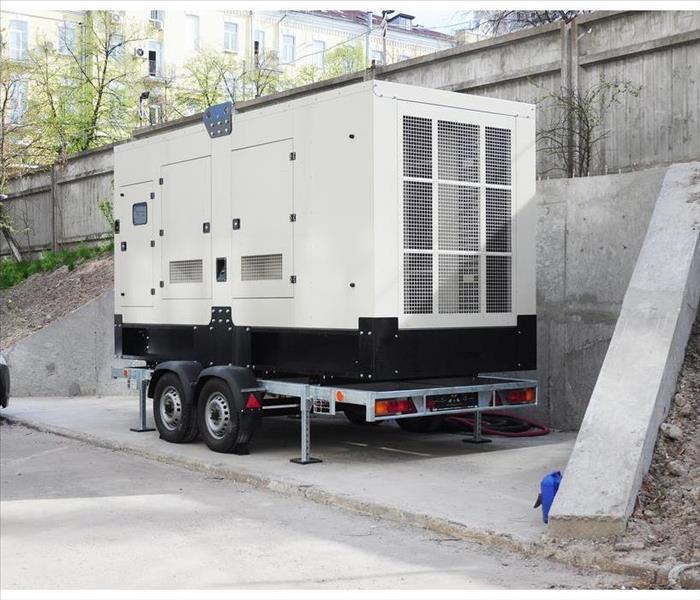 Commercial power generator.
Commercial power generator.
A severe storm can cause a power outage at your small business in Smyrna, TN. You don't need to shut down while you wait for it to return if you have a plan in place to rely on alternate power sources.
Why You Need a Back Up Plan
Severe weather, including rain, snow, hail and wind, can cause long-term damage to your business that may require the intervention of a disaster recovery service. If your business loses power, you risk additional financial harm due to:
- An inability to receive calls and emails from clients
- Reduction in employee productivity
- Lost electronic data
- Spoilage of perishable inventory
These consequences are avoidable if you use an alternate power source. Generators provide the most reliable solution for your business.
Generator Options
Choosing a generator for your business involves understanding your energy usage and the amount of space available to accommodate the unit. A portable generator is sufficient for most small businesses. It is usually mounted on a trailer and allows you to select the required voltage for specific tasks. These generators are easy to store when not in use.
Suppose a power outage at your business happens while you are not there, and losing power would cause significant hardship. In that case, you may prefer to invest in a standby generator that can kick in immediately. These generators integrate into a facility and are invaluable for businesses such as restaurants or grocery stores where food spoilage is a concern.
For businesses that handle sensitive information, such as accounting firms or medical offices, a standby generator coupled with an uninterruptible power supply is an ideal option. A UPS is a backup battery capable of running during a brief period before a standby generator begins working. It plays a vital role in the prevention of lost computer data.
Preparation Makes a Difference
When you expect weather that could lead to a power outage in Smyrna, TN, consider using a generator to continue business as usual.
How To Protect Your Commercial Building From Rain Damage
3/30/2021 (Permalink)
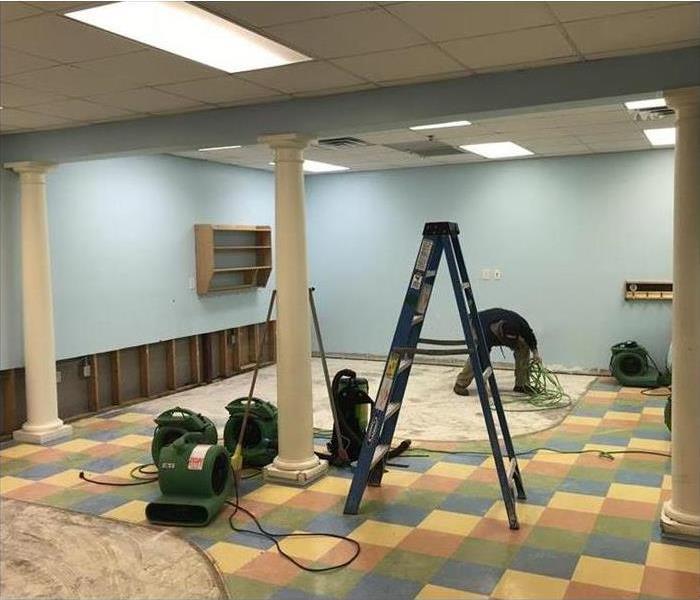 Drying equipment on a commercial building.
Drying equipment on a commercial building.
Rain damage can cause serious problems for your Milton, TN, business. Fortunately, proper maintenance can help keep the building protected and in good condition.
Prevention
To protect your commercial building from inclement weather, it is important to maintain the building envelope. The envelope is the barrier between the outdoors and indoors. An envelope is considered loose if it allows significant airflow from outside in and tight if it does not. The envelope is made up of several components:
- Roof
- Walls
- Foundation
- Windows
- Doors
Routine maintenance and regular inspections work together to keep your building's envelope strong and tight. Check for and repair cracks in the foundation and walls. Make sure the roof is leak-free and that the shingles or other roofing materials are secure. Doors and windows should be properly aligned and sealed.
Some business owners are comfortable performing inspections of the envelope themselves. Others prefer to hire a professional. Either way, it is important that the building be examined regularly to catch minor issues before they become serious problems.
Cleanup
Unfortunately, even buildings with properly maintained envelopes can suffer rain damage. If water inundates your business, it is important to act quickly to prevent structural damage and mold growth. Although black mold is the most notorious, all fungi can cause problems.
Dry the property out as quickly as possible. A certified restoration service can help with this step, but you may be able to start the process yourself if you have access to a wet/dry vacuum.
After the standing water has been removed, there will still be moisture in porous items. Fans and dehumidifiers can be used to finish drying the area. When everything is dry, professionals can help you determine what can be cleaned and salvaged and what needs to be replaced.
The building envelope is your commercial structure’s primary defense against storm and rain damage. Keeping it in good shape is the best way to protect your business from inclement weather.
How To Prevent Mold Damage After a Flood
1/15/2021 (Permalink)
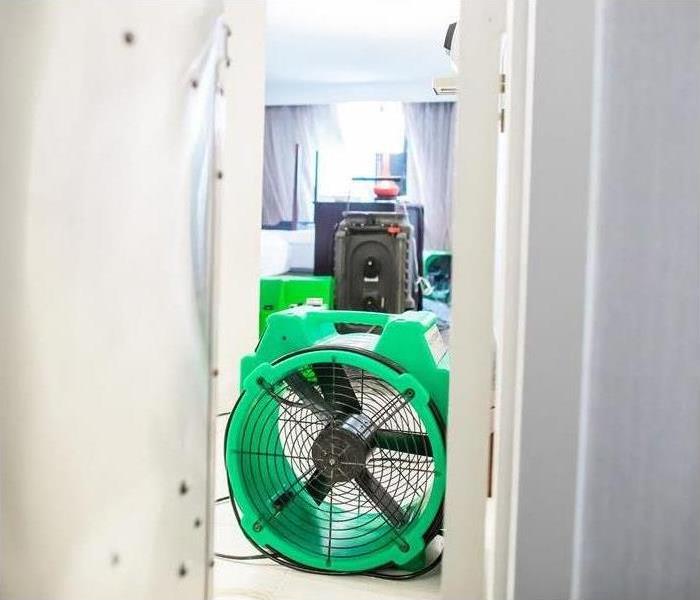 Calling a professional water cleanup service is always recommended after a flood
Calling a professional water cleanup service is always recommended after a flood
How To Prevent Mold Damage After a Flood
Major storms and hurricanes can cause severe damage to your home. Between the heavy rain and strong wind, many homes are subject to flooding in Murfreesboro, TN. If your home has suffered from a flood, it is important to act quickly to clean up your home and mitigate any loss from water damage or mold growth.
If you suspect you have mold in your home, remove it as soon as possible, as even small amounts of mold can lead to:
- Unpleasant odors
- Damage to your home
- Dark and unsightly stains
- Rapid mold growth and infestation
Dry Out Your House
If your home is flooded after a storm, you should remove standing water as quickly as possible and dry out the flooded area. The longer the water stays in your home, the more likely it is to cause damage. Damp, humid areas are a breeding ground for mold and mildew, so you need to eliminate as much moisture as possible.
Get Help Quickly
Calling a professional water cleanup service is always recommended after a flood, as they are expertly trained to handle flood cleanup and mold prevention. In addition to drying out the flooded area, they will also clean, deodorize, and disinfect your home to remove any bacteria that has seeped into your floors and walls.
Document the Damage
Remember to keep a file with all repairs and expenses to file with your insurance company if you plan to file a claim. Gather receipts that show the cost of any damaged property and any receipts from professional cleanup services. Always check with your insurance provider for coverage under your policy.
There is no time to spare when dealing with mold growth after a flood. If you think you have a mold problem, removing the water from your house and thoroughly drying and disinfecting the area is your best course of action. Getting professional help and maintaining good records will ensure that you eliminate the problem, mitigate the damage, and prevent any additional loss.
Who Pays For Flood Damage to a Rental Property?
11/11/2020 (Permalink)
 Flood damage in Christiana, TN area
Flood damage in Christiana, TN area
Understand Each Party's Responsibilities
When a rental property floods, it’s not always clear what happens next. Many leases don’t include any provisions addressing potential disasters. It’s helpful to understand each party’s responsibilities, as well as the roles that property insurance and renter's insurance play in covering the costs of flood damage.
Owner’s Responsibilities
After a flood, it’s ultimately the landlord’s responsibility to get the property back into a habitable condition. This means the owner must
Repair any structural damage to the building.
Ensure that the property has been fully decontaminated in accordance with applicable health and safety guidelines.
Replace or repair any damaged appliances or other fixtures that were included in the lease.
Most restoration expenses and repair costs should be covered by the landlord’s property insurance; however, some property insurance policies specifically exclude flood damage caused by rising water or storms. If the property is within a federal flood zone, the landlord will typically have a separate flood insurance policy to cover those expenses.
Renter’s Responsibilities
In the event of flooding, a tenant is responsible for anything inside the property that was not included with the property as part of the lease. In most cases, renter's insurance will cover damage to things like furniture and clothing. Rental insurance typically also covers the cost of alternate housing, if necessary, until flood damage remediation is complete.
Like property insurance, most rental insurance policies do not cover flood damage caused by storms or rising water. However, there are specific flood policies available to renters, especially for properties in flood-prone areas. FEMA also offers some disaster relief options for renters impacted by storm-related flooding. Renters can check FEMA’s website to see whether Christiana, TN, is included within a federally declared disaster area.
Flooding can be a gray area when it comes to insurance coverage for property owners and for tenants. If the rental property is in a flood zone, tenants should consider purchasing a flood policy to cover flood damage not covered by ordinary renter's insurance.
How To Prevent Mold Growth After Water Damage
10/20/2020 (Permalink)
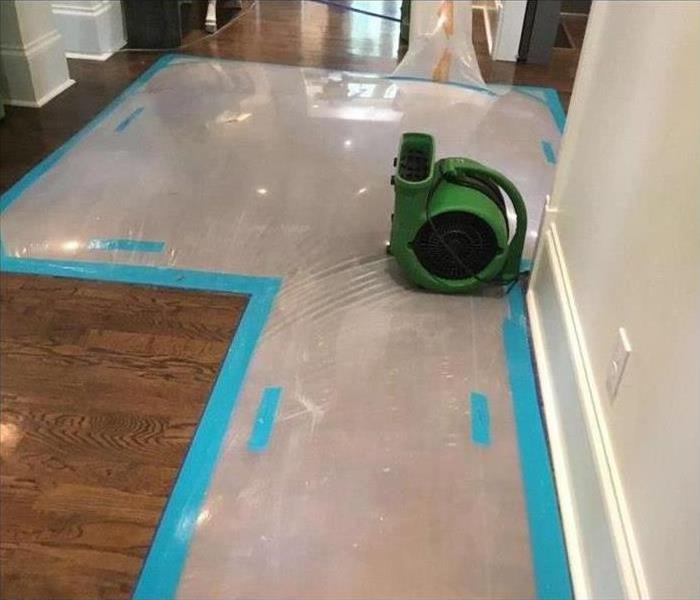 Drying process in a Murfreesboro, TN home
Drying process in a Murfreesboro, TN home
Water Cleanup Process
If your Murfreesboro, TN, home experiences water damage, it is important to act quickly to prevent mold growth. The following steps outline the water cleanup process. These steps apply regardless of the source of the water.
1. Make sure it is safe to begin work. Water and electricity can be a dangerous combination. Make sure the power is off in all the affected areas. If you cannot do this yourself, call an electrician.
2. Document the damage. Before you begin repairs, be sure to take photo or video evidence of the damage. This will help the insurance company properly compensate you for the loss. Call your agent and ask if there are any special instructions regarding documentation.
3. Dry the property. Because standing water can lead to mold growth within 24 hours, it is important to complete this step as quickly as possible. You can use specialized pumps and vacuums to extract the water. If necessary, you can also use buckets to scoop out the water. After the standing water has been removed, there will still be moisture left in porous surfaces. Dehumidifiers and fans can speed the drying process for these items. If the humidity outdoors is low enough, you can also open windows and doors to increase airflow.
4. Clean the affected areas. Depending on the source of the water, it may be contaminated with bacteria. Fortunately, there are many cleaning products on the market today. Choose one appropriate for the surface and contamination level you are dealing with.
5. Repair and replace damaged items. Everything that cannot be fully cleaned and dried should be thrown away to prevent contamination, mold growth, etc. Other items may be restorable. Delicate items, including electronics and antiques, will likely need professional restoration. Depending on their skill level, homeowners may be able to complete some of the other repairs.
The water damage restoration process can be overwhelming, especially if it has led to mold growth. If you need help getting your home back to normal, a certified restoration service can do the job quickly and safely.
How To Run Your Business During a Power Outage
9/9/2020 (Permalink)
 Look for a Wi-fi connection you and your employees can connect to
Look for a Wi-fi connection you and your employees can connect to
Strategies To Keep Your Business Running During A Power Outage
Modern technology provides amazing tools for your Lascassas, TN, business. Yet because you rely so much on electronics, a major storm could be devastating. Heavy rains may cause flood damage to important appliances and devices. Meanwhile, lighting and strong wind could lead to a power outage.
Still, there are ways to overcome these obstacles. Storm cleanup specialists can dry off your property and restore your company's assets. You can even continue running your business while the power is out. Just follow the below suggestions.
1. Take Advantage of Data Packages
While electricians work to restore power in your building, you can access the internet on your phone or mobile device. Your tablet or cell usually includes a data package that lets you send emails and perform other essential business functions without an internet connection.
You should thus utilize these devices until they run out of battery life. Avoid running games or apps that could drain the phone's battery.
2. Use Wi-Fi
Find a local coffee shop or convenience store that did not suffer a power outage. The business may have a Wi-Fi connection that you and your employees can use.
3. Work Offline
Not every work task requires electricity. Use the outage to fill out paperwork, brainstorm, or perform other jobs that can be done without a computer or internet.
If you find out that a storm is heading your way, you should also prepare for a potential outage. Purchase a portable generator that will keep the electricity working in your building. You should also install an uninterrupted power supply on each computer. This way, if the power does go out, you and your employees will have time to save any unsaved data before the device shuts down.
A heavy storm does not have to destroy your business. Flood cleanup experts can help you repair the physical damage to your property, including the electronics. You can also utilize the above strategies to keep your company running during a power outage.
What to Do When a Storm Cancels Your Flight
8/7/2020 (Permalink)
 A canceled flight can occur for any number of reasons
A canceled flight can occur for any number of reasons
What to Do When a Storm Cancels Your Flight
Planning your upcoming vacation or business trip around air travel is certainly a gamble. When the trip goes smoothly, everything is great. However, this is isn't always the case. A canceled flight can occur for any number of reasons, but storm cancelations are the most common offenders.
Preparation is Key
Air travel is notoriously unpredictable, so planning before your trip is absolutely vital. You do not want to get stuck in the middle of a busy airport without a back-up plan in the event of a canceled flight. Follow these storm tips to help your trip run smoothly:
- Check the weather ahead of time
- Fly direct, if possible
- Avoid layovers in cities with notoriously bad weather
- Pack light and try to avoid checking a bag
- Arrive at the airport early
- Get through security as quickly as possible
Planning ahead is never a waste of time. At the very least, your readiness will give you peace of mind.
When Your Flight is Canceled
Bad weather is not always avoidable. Don't panic if your flight does get canceled. The first thing you should do is call your airline. The airport will tell you to get in line with all of the other unlucky passengers, but you can avoid this queue by simply picking up your phone and calling the airline directly.
Once you have someone on the line, you can attempt to reschedule your flight. If you're lucky, you might be entitled to a bit of compensation for your troubles.
When You Can't Get Home
Worst case scenario, you might not be able to hop on the next flight home to Christiana, TN, until the following day. While this is certainly a pain, it isn't the end of the world. Book a nearby hotel so you can start fresh and, hopefully, make it home in the morning without too much fuss.
Don't let a canceled flight ruin your travel plans. Follow these travel tips and consult storm experts to avoid running into trouble on your next flight.
5 Tips to Keep Your Sump Pump Running Like a Champ
5/1/2020 (Permalink)
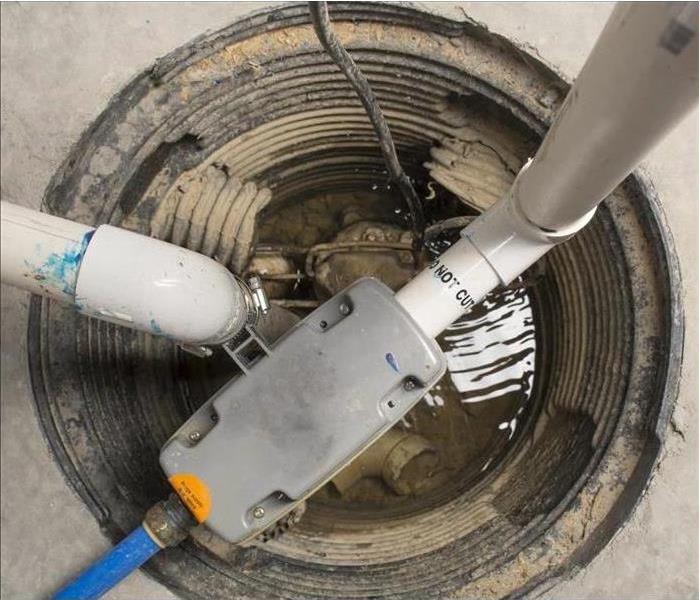 A working sump pump is essential for most basements in Walterhill, TN
A working sump pump is essential for most basements in Walterhill, TN
Five Basic Steps To Perform Pump Maintenance
A working sump pump is essential for most basements in Walterhill, TN. As part of the invisible infrastructure, it’s typically only noticed when it isn’t working right. However, they do require some maintenance to remain in service for a long time. When neglected, they have a nasty tendency to break down during the heaviest needs, leaving you with a potential disaster.
There are five basic steps to performing pump maintenance:
- Test the ground fault circuit interrupter (GFCI).
- Test the backup battery.
- Test the trigger mechanism.
- Clean the pump screen and inspect for objects blocking inlet or discharge.
- Inspect the sump pit for debris.
Most Sump Pumps Are Wonderfully Simple Devices (Yet Perform a Vital Function)
In wet soil or in areas with a high water table, it’s natural for water to try to migrate into a basement. A sump pit is dug where the water would naturally accumulate and may have additional lines run to the pit to facilitate the flow of water. Once the water level reaches a certain point in the pit, the sump pump in the pit is designed to automatically turn on and shut off as needed.
Most Maintenance Is Simple
A GFCI circuit has a button labeled “test.” Press that button to see if it trips. If it does, reset it with the “reset” button; if not, you’ll need an electrician to repair it. The backup battery (if it has one) should also have a button to test it. You can also test the sump pump trigger by either manually (and carefully) lifting the float valve or pouring in enough water to actuate the pump.
Cleaning the screen and pit is relatively simple for those comfortable with basic machines. The pump should easily detach so you can inspect for blockage in the screen, hoses, or the pit itself. Simply remove the debris and reinsert the pump.
If you aren’t comfortable doing this (or if it’s not working right), you should call a local company used to working with water damage and pumps. They can help you deal with flood damage as well.
Don't Let the Storm Shut You Down: How To Get Back Work Quickly
4/12/2020 (Permalink)
 How to get back to work quickly
How to get back to work quickly
Don't Let the Storm Shut You Down: How To Get Back Work Quickly
Business owners in Rockvale, TN, realize that flood water is a major obstacle. Something such as natural liquid may seem innocuous, yet it has the ability to bring everything to a complete halt. No structure and no merchandise simply mean a closed shop, unproductive and profitless. Therefore, proprietors should be proactive, taking measures to reduce the destruction and get repairs swiftly. Start taking on projects again by considering taking these three steps.
1. Review Your Claim
A flooded building doesn't always mean you have coverage. When word of a storm begins, start looking over your policy. What does it say about water damage? Is flooding covered? If not, you may want to see if you can make changes. If you do, what is the deductible? In addition, understand the procedure for filing a claim. Keep all of this information close by where you can access it once the water subsides.
2. Prep the Building
Before the flood water hits the premises, do a few things to salvage what you can:
- Fill in any cracks along the walls, attempting to prevent any moisture from getting inside.
- Establish a border to minimize the fluid, placing sand bags along the perimeter.
- Move as many items to higher ground, trying to keep them dry.
- Check on the air and gas, making sure they are turned off.
- Create backup files of data, helping give you access to necessary information easily.
Mitigating the issues can increase the speed with which you open back up the doors.
3. Hire Remediation Services
As soon as possible, hire a storm restoration company in Rockvale, TN, to handle the water damage. They can evaluate the water-logged structure, determining the appropriate procedures to get your doors back open. They'll begin by tearing out contaminated sections, drying out the room and sanitizing the space. Once completed, patching and paint occurs, so that your work can continue.
With flood water invading your space, you're establishment's tasks will stop. By taking precautionary actions and seeking assistance, you can start up again.
Quick Commercial Storm Damage Cleanup
3/26/2020 (Permalink)
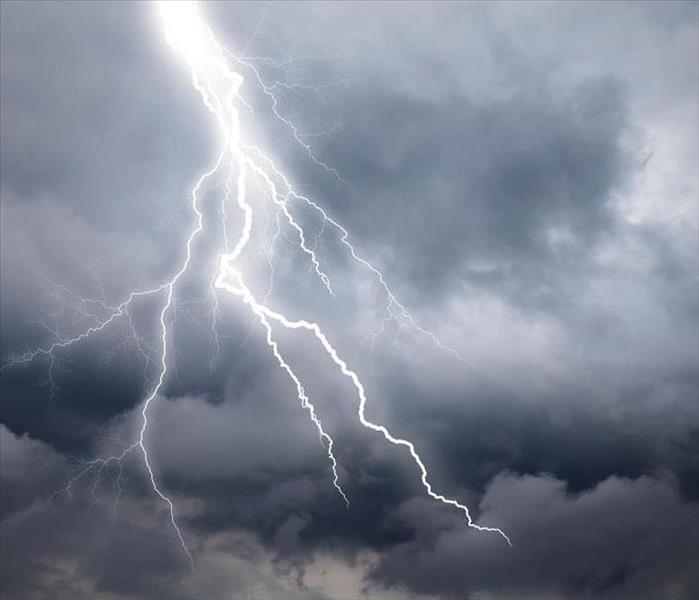 If a storm does damage to your property, give us a call.
If a storm does damage to your property, give us a call.
Just like any other building, commercial buildings are subject to the costly damages of Mother Nature’s wrath. Depending on your location and the season, losses can be caused by blizzards, hurricanes, earthquakes, and tornadoes. But one of the most common weather disasters is storms.
You can predict the storm, but cannot predict the extent of damage it will have on your commercial building. Flooding is often the biggest concern in this regard.
According to National Geographic, flooding accounts for more than $6 billion in damages every year. While typical floods may happen over days, flash floods can destroy properties in minutes.
The serious structural and cosmetic damage of your commercial building is more than just a headache to business owners – it’s a source of huge financial loss and an interruption to the normal operations of your business.
After a storm, you may want to replace everything and start from scratch. But this is not the best option as it is way too expensive, especially at such a time. Instead, you can try restoration.
Get the Right Commercial Storm Cleanup Services
A professional restoration company is able to handle all of your commercial damage cleanup and repairs. And since there is never a convenient time for flooding and storm damage, get a company that is available 24/7. Keep in mind that every hour wasted is an hour of lost productivity and revenue.
SERVPRO has the experience, training, and equipment to handle small and large commercial storm damage emergencies. Our technicians respond quickly to clean the mess and manage the restoration project from start to finish.
6 Main Stages of Our Commercial Storm Cleanup Services
This brief overview explains how SERVPRO experts may approach to resolve the storm damage at your commercial building:
- Examine the Damage: The restoration specialists will assess the extent of the damage and discuss the results with you and your insurer.
- Prevent Secondary Damage: This step involves boarding and tarp up services which prevent secondary water damages.
- Remove the Standing Water: With industry-leading vacuums and pumps, our restorers will be able to completely remove the water from the affected areas.
- Remove Damaged Building Materials: Damaged materials should be carefully removed and properly disposed of prior to the cleaning process.
- Clean and Disinfect the Surfaces: Our technicians will use customized cleaners to disinfect the affected surfaces as well as restore salvageable items.
- Dry the Building: Commercial air movers and dehumidifiers will facilitate the drying process and prevent the growth of mold and mildew on surfaces. Building materials are replaced after the affected areas are completely dry.
- Repaint and Add Final Touches: When walls are exposed to excess moisture for a few hours, they absorb water, and this may cause the paint to flake. When the walls are completely dry, our experts will repaint them for a dazzling finish.
What Next After the Commercial Storm Damage Cleanup?
As a property manager, a disaster preparedness plan will go a long way toward addressing your flooding concerns. You cannot stop the storm, but you can take the necessary actions to keep your building from another water-related disaster.
After the cleanup, consider the following preventive measures:
Flood-Proof Your Building
If flooding has been a problem in the past, consider flood-proofing your commercial building. This will prevent water-related damages in the future. One of the best practices is covering your building with a waterproof coating to keep water from seeping in.
Improve Your Landscaping
If possible, try to elevate the area around your commercial building before the rains begin. You can also build a system that will allow water to flow away from the building. Don’t forget to install downspouts to direct water away from the foundation.
The cost of this project will depend on the size of your building. Nonetheless, this cost will be far less expensive than the cost of repairing the damage.
Pay Special Attention to Basements
After a storm, the basement and foundation of your building may face serious damage.
It’s recommended to contact a specialist who will patch the foundation walls and caulk huge cracks. Moreover, you should consider installing a sump pump and dehumidifiers to keep the building dry always.
SERVPRO Will Be With You All Through the Commercial Storm Damage Cleanup
In the unfortunate event your commercial building is damaged by a storm, then do not hesitate to call SERVPRO in Smyrna, Rutherford County, for help. We will not only restore your property, but we will also help you review and make recommendations to safeguard your building from future storm damage.
Storm Damage Cleanup Made Easier
3/25/2020 (Permalink)
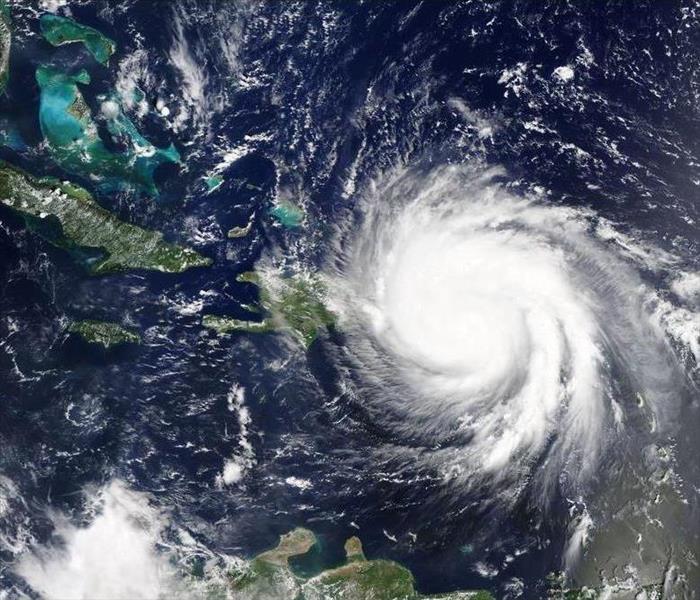 We can handle any sized storm loss
We can handle any sized storm loss
It’s hurricane season once again! This season always comes with storms and flash floods that can destroy massive amounts of property, both outside and inside homes.
If your home has ever flooded, then you understand how stressful and challenging the cleanup process can be. From ruined electronics to soaked carpets, water damage is a headache to homeowners.
If you want to take on smaller and safer tasks before help arrives, make sure that you are protected. The Environmental Protection Agency (EPA) recommends that you wear boots, long pants, a long shirt, gloves, and an N-95 respirator to protect against mold spores.
Unfortunately, the flooding experienced from a storm is a far too serious matter to handle alone.
Here’s Why Storm Damage Cleanup is Not for Everyone
Flood waters can destroy your home in the following ways:
- HVAC: When water enters the internal components of air conditioners and heaters, it damages its electrical systems. The venting system can also be contaminated by mold, and it may require professional cleaning to prevent mold spores from being blown through the air.
- Home Appliances: Flood waters can short out these appliances and make them leak harmful gases into the air. They need to be repaired and cleaned by a professional before use.
- Electrical Wiring and Pipes: Storms can strip electrical wiring and break water pipes. Work with a contractor if you notice these damages. For safety purposes, do not try to repair the problem yourself.
- Painted Concrete: Concrete walls flake when exposed to excess moisture and may require repainting. Concrete floors, on the other hand, are quite absorbent and will develop whitish deposits when exposed to moisture. Restorers should use HEPA vacuuming and EPA-registered disinfectants to get rid of these deposits.
- Floor Coverings: Most carpets are usually thrown out after they are damaged by standing water. However, a professional cleaner is able to restore your valuable carpets. Just remember to remove the soaked carpets from the flooded house as soon as possible to minimize the damage.
- Furniture and Other Wooden Items: Solid wood items may weaken, warp, and crack following a flood. Fortunately, they can be saved when dried properly.
- Insulation: Insulation foam sheets that have been affected by flood water need to be hosed off and dried. However, cellulose insulation made of treated paper needs to be replaced and removed.
- Plaster: Even though this thick material may not be replaced, it may take a really long time to dry. Professional storm damage cleanup companies have the necessary equipment to dry plaster quickly and more efficiently.
- Drywall and Wallboard: These are porous materials that become very fragile when wet. If they are not dried out properly, they can get contaminated.
Hiring a Storm Damage Cleanup Professional
Cleaning up after a storm is a dangerous task, and should largely be left to professionals.
SERVPRO may be in a position to help you during this difficult time. We are a locally-based storm damage cleanup company in Murfreesboro of Rutherford County. Our highly skilled experts have access to industry-leading equipment to quickly reverse the effects of water damage.
Restoration is better and far less expensive than replacement.
Before the cleanup process begins, the experts will examine the extent of the damage outside and inside your home. The results will be discussed with you and your insurer.
The type of damage present will determine the types of restoration equipment and tools needed. In the case of flooding, specialized vacuums and pumps will be used to remove water from the affected areas.
When drying your house, there are four main considerations that come to play – temperature, humidity, air movement, and the amount of water present. Drying occurs faster under low humidity levels and high temperatures.
Moreover, the damp air in the water-damaged rooms should be replaced by dry air to hasten the drying. Commercial air movers and dehumidifiers can facilitate the drying process and prevent the growth of mold and mildew on surfaces.
Our specialists will also use customized cleaners to disinfect the surfaces as well as restore salvageable items. Minor house repairs will be done and air fresheners will be used to combat the damp odor of a flooded home. Your house will be restored to its pre-storm state in no time!
SERVPRO is Available 24/7 for Professional Storm Damage Cleanup Services
Natural disasters like storms come without warning and they can flood and damage your property. But if you act fast, SERVPRO of Rutherford County can restore your home. Call us today!
4 Storm Preparation Tips That Will Help Your Business Survive a Storm
2/28/2020 (Permalink)
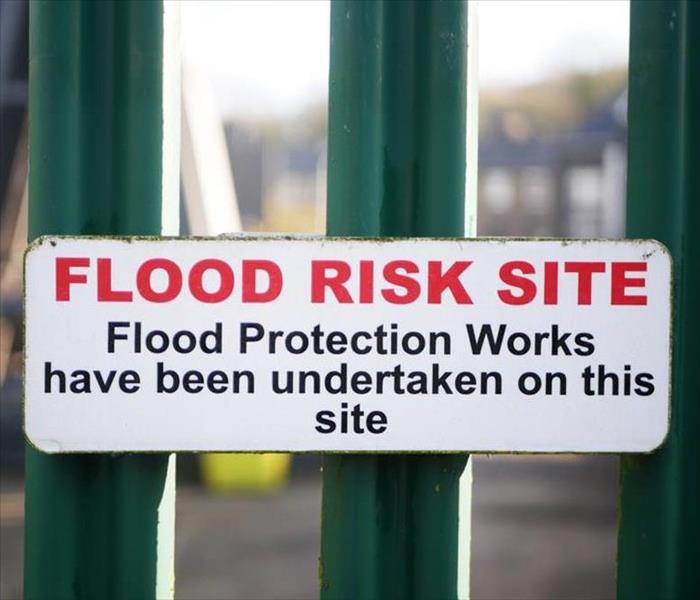 Be prepared for the worst!
Be prepared for the worst!
Storm preparation is vital for any company. A flooded building can disrupt business and stop an inflow of income. Along with that, flood water can cause a lot of damage and may require restoration services. Here are a few ways you can prepare your building to reduce risks of flooding and save money.
1. Back Up All Critical Information
If important documents or technology get ruined in a storm, this information may be gone forever. Back up anything important on hard drives and have copies of documents in a secure location. That way, once the aftermath has cleared, your company can continue to run smoothly.
2. Consider Flood Insurance
Whether you are in a mapped flood zone or not, it’s a good idea to have flood insurance. Flood water in the building can completely disrupt business if one affects your building. This can help you cover restoration expenses as well as business and employee costs.
3. Have Emergency Kits Ready
The most important part of your business is your employees. Have emergency kits ready for any disaster. A few important emergency kit supplies include the following:
• Enough water to last 24 hours
• Flashlights
• First-Aid kits
• Batteries
• Non-perishable food
If a disaster does occur, you can be confident that your employees will be taken care of.
4. Waterproof Your Building
If your business in Murfreesboro, TN, is based in an old or leaky building, consider doing any repairs that might stop water from entering the building. Caulk any cracks, install a drainage system, and add waterproof sealant to anything that might result in a leak.
Although you may never deal with flood water in your commercial building, it doesn’t hurt to take precautions to reduce the water damage if a flood were to occur. If a severe storm does affect your business, take care of your employees and call in restoration services quickly. Once everything is repaired and secured, your business can start up again.
How Storms Can Damage the Roof of Your Business or Home
2/26/2020 (Permalink)
 Check your roof after a major storm
Check your roof after a major storm
The roof of your home or business is important. A well-maintained roof promotes energy efficiency and protects the building from the elements. When the roof withstands damage, the integrity of the building is affected. If a storm damages your roof, SERVPRO of Rutherford County is the company to call for cleanup and restoration.
Surveying Your Roof After a Major Storm
Commercial and residential property owners should have their roof inspected after major storms. High winds as well as heavy rains and hailstones can damage a roof in many ways. They can cause shingles to blow off individually or in full patches. Tree limbs can fall onto the roof to leave a hole in the structure. We do not advise you to climb onto the top of the building on your own because of the high elevation and steep incline of most roofs. If you believe that your property has been damaged by a storm, you should contact a professional for an assessment.
What We Can Do to Recover and Restore Your Property
Our staff is highly trained in property damage restoration. SERVPRO’s Corporate Training Facility ensures we are always up to date on the best techniques to get your home or business back in shape after a storm. Regular IICRC industry certifications, means we have the knowledge as well as the equipment to restore your property. We clean the damage the storm left behind, and this includes on the interior or exterior of your building.
Severe weather is unfortunately common in the Middle Tennessee area, and it can cause significant damage in a very short period of time. SERVPRO of Rutherford County is available to respond to requests immediately after a major storm. We can begin the restoration and cleanup process quickly so that you can more easily move past the current issue and protect your property.
Storm Damage: Tips for before and after a major storm
10/27/2019 (Permalink)
Storm damage is difficult to avoid entirely. You can't control the weather, but you can be proactive and keep your home or business as safe as possible. SERVPRO is standing by to help you recover from any size or type of storm. Here are five things you can do to prevent storm damage to your property.
Take "Before" photos ahead of major storms
When a significant storm is headed your way, document the current condition of your property and valuable belongings. As safely as possible, take photos or video of your home or building. Document the condition of your roof, siding, windows, gutters, drainage systems, and any sheds or storage houses.
These "before" photos will help with the insurance claims in the event of significant storm damage. This is particularly helpful for commercial property owners and property managers.
Batten down the hatches
The easiest way to prevent storm damage is to keep your home or building in peak condition.
Roof, siding, windows, and doors
Schedule annual or semiannual roof inspections. Your roof is the first line of defense against storm damage, but roof damage can be difficult to see with a naked eye. An expert roofer will repair or replace loose, cracked, missing, or damaged shingles.
If you are preparing for a particularly strong storm, consider laying tarps and plywood on your roof to help prevent shingles from getting ripped off. The tarps can act as an extra layer of protection to keep water out and to avoid wind damage.
Visually inspect the siding on your home. Repair any loose siding that might get ripped off in a strong wind. Wind only needs a small crack to lift siding or shingles off your home. Replace any damaged siding that might allow water to seep into the walls.
Make sure your doors, windows, and skylights have reliable seals to keep out the wind, rain, and cold. If you are preparing for a hurricane or strong winds, it is essential to cover your windows with plywood or storm shutters.
Gutters, landscaping, and drainage
Clear your gutters, drainpipes, or flat-top roof of any debris. Leaves and branches can clog your gutters, causing it to overflow. In warm weather, overflowing water can flood into your home. In cold temperatures, standing or overflowing water can freeze, causing damage to your roof.
Keeping your landscaping maintained is an easy way to prevent all kinds of storm damage. Prune trees and shrubs to clear dead or diseased branches that might fall and damage your property. Make sure you keep at least 3 feet of space between your home and any tree branches or shrubs.
Regularly check the trees on your property for damage like cracks in the trunk, mushrooms growing on the trunk (that indicates decay), or branches that cross or interfere with each other.
While you are inspecting the landscape, check for loose fence posts, light posts, and similar structures around your property. Shake each post to test its strength and stability. Even loose fence posts can become dangerous in a strong storm.
Make sure water flows away from your home or business into a ditch or drain. Standing water or flooding during a major storm can cause flooding in your home.
Patio furniture and outdoor items
If you are preparing for a particularly strong storm (like a hurricane or nor 'easter), consider bringing lawn ornaments, patio furniture, garbage cans, grills, and other items indoors. If you cannot bring them in, make sure they are tied down. In a powerful storm, nearly anything can become a dangerous projectile.
Avoid ice damage
Keep your attic insulated properly. This reduces heat loss through your roof, which makes your home or business more energy-efficient and helps prevent ice damage.
As the heat escapes from poorly insulated attics, it melts snow and ice, which can refreeze, creating an ice dam. The ice dam causes water to "back up" under the shingles or fascia boards and soak through the roof and walls.
Immediately after the storm
It is important to assess your property as soon as possible. Finding damage as quickly as possible after the storm can help you minimize damage and save time and money.
Look for signs of water damage inside
While it is still raining or immediately after the storm, inspect your property for signs of water damage. The most obvious signs of water damage are puddles and dripping water. Also, look for stains and discoloration on the ceiling and walls. There may be more water inside the wall or ceiling that can cause more damage.
Mark any leaks you find with tape. When the rain stops or the water dries, it might be challenging to identify the exact location of the leak again. The marks will help SERVPRO experts identify and resolve the issue more quickly.
Check the basement and crawl spaces for water damage. Make sure no water is seeping in and that your sump pump or drainage systems are working.
If you find any water damage, take photos from different angles. Documenting everything as thoroughly as possible will make filing the insurance claim much more manageable. SERVPRO technicians can help you record any damages and relay that information to your insurance provider.
Assess the outside of your property
As soon as it is safe, begin to assess the exterior of your home or business carefully. Stay clear of any downed power lines, damaged trees, and floodwater.
Check for cracks, chipping, and dents in the siding, brick, or stucco. Discoloration is another indication of damage to bricks and siding. Even small cracks or holes require attention from a professional. Make a point to inspect the outside several times after the storm. Different lighting can reveal damage that is easy to miss.
Inspect your air-conditioning units, fences, vent caps, and other things on your property that may have incurred damage.
Contact your SERVPRO professionals who are ready to help you restore your home or commercial property to its original condition after storm damage. We are available 24/7 and equipped to handle any size disaster.
Preventing Storm Damage to Your Commercial Roof
10/23/2019 (Permalink)
When there is a significant storm on the horizon, you might not be able to control the weather, but you can take proper steps to protect your property.
SERVPRO would rather help you prevent damage, but we are available 24 hours a day to clean and restore any property damage. Our trained technicians are ready to repair all kinds of storm damage.
Roof damage can quickly lead to other kinds of property damage. Here are some practical tips for protecting your commercial roof from storm damage.
Preventative maintenance is the first line of defense
The easiest way to prevent storm damage to your commercial roof is to follow the recommended preventative maintenance schedule. Have a roofing expert inspect your roof annually or semiannually. It is easier to repair small issues before they become significant problems.
Remove debris and hazards
Storm damage often comes from blocked storm drains. Clean any loose debris and make sure there is no standing water. Loose roofing materials, branches, leaves, and other debris can prevent water from draining correctly.
Remove hazards like overhanging limbs and weak roofing sections. Trim branches and bushes to at least 3 feet away from your building. This prevents leaves from blocking drainage systems and reduces the risk of damage to your roof.
Make sure the HVAC systems, satellite dishes, and other equipment are anchored correctly. During a storm, these can cause blunt force damage. Loose material blowing across rooftops cause up to 70% of roof damage during a hurricane.
Waterproof a flat roof
Cold temperatures can cause asphalt-based roofing materials to crack. Hot weather can cause "crazing" and bubbles. If you have a flat roof, invest in regular waterproofing treatments to prevent moisture damage. Make sure the roof hatch and access doors close tightly to prevent water seeping into the building.
Extra preventative measures
If you know a strong storm is on the way, lay tarps and plywood on your roof. The tarp holds shingles in place and adds an extra layer of defense against water.
If you live in an area with frequent, intense storms and high winds, consider replacing your asphalt roof with more durable metal, plastic, or stone materials.
After a storm
Immediately after a storm, look for leaks and evidence of water damage inside your building. Once the weather clears and water dries, it can be challenging to find the leaks. It's best to inspect your property immediately after a significant storm or while it is still raining.
Check your roof for damage and holes that might allow more water, bugs, or debris to get into your building.
If you find any water damage inside your building, immediately phone your SERVPRO technicians and your insurance provider to alert them of the damage. Roof leaks shorten the life of your roof. Untreated water damage can lead to more significant issues throughout your building, like mold and mildew.
Protect your property
Even small amounts of water damage can become a significant problem. As soon as you discover water damage or a leak in your roof, move inventory and property to a safe place or cover it to keep everything dry. Avoid any wet electrical equipment. Contact an electrician immediately if the roof is leaking onto electrical equipment.
Document any water or storm damage for your insurance provider.
Stay off the roof
Storm and water damage can compromise the integrity of your roof. Avoid the temptation to assess the roof yourself. Instead, call your roofing contractor who has the proper training and equipment to inspect your roof safely.
When the roofing contractor arrives, ask them to take photos of any damage for your insurance claims.
Let SERVPRO handle the restoration
A leaking roof can let water seep into insulation, drywall, and other building materials. It is essential to make sure everything dries thoroughly to prevent mold, mildew, and other structural issues.
After our SERVPRO technicians inspect your building and determine the scope of the damage, they use specialized equipment, sensors, and infrared cameras to identify hidden moisture, in ceilings, walls, and flooring that is very difficult to see.
Our technicians use pumps, fans, and wet/dry vacuums to clean up any excess water. We remove any drywall, insulation, and other materials that cannot be dried and repaired.
When everything is dry, our technicians repair everything as quickly as possible so your business can get back up and running. We can even help you with your insurance claims!
 Extreme temperature changes can lead to severe weather. SERVPRO of Rutherford County is a click away if you experience any damage.
Extreme temperature changes can lead to severe weather. SERVPRO of Rutherford County is a click away if you experience any damage.



 24/7 Emergency Service
24/7 Emergency Service
















